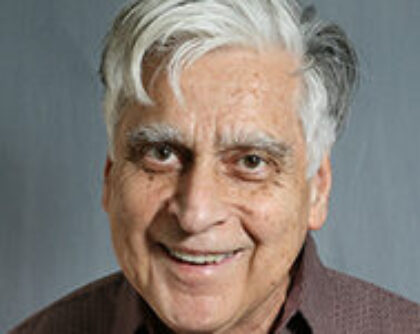Earle Lomon
In Memoriam: 1930-2025
Research Interests
Quantum Chromodynamics (QCD), the dynamics of quarks and gluons, is the modern theory of hadrons (strongly interacting particles), determining their structure and interactions. The non-perturbative and perturbative properties of QCD may both be expected to be important in hadronic interactions at intermediate energies. A model which appropriately includes the long range confinement and short range asymptotic freedom aspects of QCD can be compared with experiments to clarify our understanding of the transition between these two extremes of theory.
Professor Lomon is very interested in these questions and has adapted the R-matrix boundary condition method to provide a model that may include enough of the physics to be compared with data and predict new features. Its main aspects are the inclusion of coupled isobar channels interacting via meson exchange at large range, coupled to perturbative quark/gluon degrees of freedom at short range. The model has been applied to several baryon-baryon systems (of strangeness 0, -1 and 2) and to the strangeness +1 kaon-nucleon system, successfully predicting their known properties and predicting new “exotic” resonances related directly to the behavior of simple multi-quark configurations.
There is some experimental evidence for the existence of these resonances. Present research is concentrating on the observable properties of the S=-2 baryon-baryon system, which is expected to have a low energy resonance; refining predictions in the S=0 nucleon-nucleon system, for which quality data is being produced at new intermediate energy accelerators; and on the high momentum transfer electromagnetic form-factors of the deuteron to compare with new data from the energy electron accelerator at Jefferson National Laboratory.
Biographical Sketch
A nuclear theorist, Earle earned his PhD from MIT in 1954 and did postdoctoral work at the Institute of Theoretical Physics in Denmark, the Weizmann Insittute of Science in Israel, and Cornell University. He was then appointed as an Associate Professor at McGill Uniersity in his hometown of Montreal before returning to MIT as an Associate Professor in 1960. A founding member of the Center for Theoretical Physics (now MIT Center for Theoretical Physics — a Leinweber Institute (CTP-LI) in 1968, he was promoted to Professor in 1970 and retired in 1999.
Earle’s research focused on the interactions of hadrons — protons, neutrons, mesons, and nuclei — before it was understood that they were composed of quarks and gluons. He was interested primarily in the forces between protons and neutrons at low energies, where the effects of quarks and gluons are hidden by their confinement. When QCD emerged as the correct field theory of hadrons, Earle moved quickly to incorporate the effects of quarks and gluons at short-distance and high energies. Earle’s work can be interpreted as a precursor to modern chiral effective field theory, where the pertinent degrees of freedom at low energy, which are hadrons, are matched smoothly onto the quark and gluon degrees of freedom that dominate at higher energy.
An APS Fellow, former Guggenheim Fellow, and a member of the Canadian Association of Physicists, Earle also had a multi-decade association with Los Alamos National Laboratory as a Visiting Scientist. He also served as a program officer for the National Science Foundation during 2001-2013.

Professor Emeritus Earle Lomon, nuclear theorist, dies at 94
Lomon focused on the interactions of hadrons and developed an R-matrix formulation of scattering theory.
